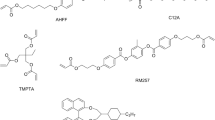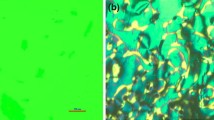Abstract
In order to improve our understanding of the mechanisms involved in the electrooptical effects of liquid crystal—polymer composites, and to identify the relevant parameters of these complex systems, we have investigated the influence of the chemical nature of the polymer surface on the anchoring of the liquid crystal. Our method consists in removing the liquid crystal from the composite by dissolution followed by supercritical drying of the solvent. The surface of the polymer is then modified by different reagents and the liquid crystal is reintroduced to the cell.
Comparison of the results shows that for a cyanobiphenyl liquid crystal, fluorinated or hydroxylated chemical moieties on the surface of the polymer induce a stronger anchoring than alkyl moieties. This phenomenon seems to be due to the enhanced chemical compatibility between the liquid crystal and the surface of the polymer in the case of alkyl moieties. Finally, the study has shown that a reduction of anchoring of the liquid crystal is responsible for a decrease in driving voltage, rise time and hysteresis and an increase in decay time and off-state transmission.
Similar content being viewed by others
References
J. L.West: Mol. Cryst. Liq. Cryst. Inc. Nonlin. Opt. 157, 427 (1988).
P. S.Drzaic: J. Appl. Phys. 60, 2142 (1986).
J. L.West: ACS Symp. Ser. 435, 475 (1990); L. Bouteiller, E. Chastaing, P. Le Barny, F. Massié, P. Robin. Revue Technique Thomson-CSF 26, 115 (1994).
J. W.Doane: ‘Polymer dispersed liquid crystal displays’, in B.Bahadur (Ed.), Liquid Crystals Applications and Uses, Wold Scientific, Singapore, p. 362 (1990).
K.Takizawa, H.Kikuchi, H.Fujikake, and M.Okada: Appl. Phyl. Lett. 56, 999 (1990); K. Takizawa, H. Kikuchi, H. Fujikake, Y. Namikawa and K. Tada: Jpn. J. Appl. Phys. 33, 1346 (1994).
R. L.Sutherland, L. V.Natarajan, V. P.Tondiglia, and T. J.Bunning: Chem. Mater. 5, 1533 (1993); R. L. Sutherland, V. P. Tondiglia, L. V. Natarajan, T. J. Bunning, and W. W. Adams: Appl. Phys. Lett. 64, 1074 (1994).
J. L.West, J. W.Doane, Z.Domingo, and P.Ukleja: Polymer Preprints 30, 530 (1989).
D. S.Parmar and J. J.Singh: Appl. Phys. Lett. 61, 2039 (1992); D. S. Parmar and J. J. Singh: Mol. Cryst. Liq. Cryst. 225, 183 (1993).
T.Kajiyama, Y.Nagata, S.Washizu, and M.Takayanagi: J. Membrane Sci. 11, 39 (1982); S. Shinkai, K. Torigoe, O. Manabe, and T. Kajiyama: J. Am. Chem. Soc. 109, 4458 (1987); J. A. Ratto, S. Ristori, F. Volino, M. Pineri, M. Thomas, M. Escoubes, and R. B. Blumstein: Chem. Mater. 5, 1570 (1993).
H.S.Kitzerow: Liq. Cryst. 16, 1 (1994); D. Coates: J. Mat. Chem. 5, 2063 (1995); L. Bouteiller and P. Le Barny: Liq. Cryst. 21, 157 (1996).
N. A.Vaz and G. P.Montgomery: J. Appl. Phys. 62, 3161 (1987); P. S. Drzaic and A. M. Gonzales: Mol. Cryst. Liq. Cryst. 222, 11 (1992).
G.Chidichimo, G.Arabia, A.Golemme, and J. W.Doane: Liq. Cryst. 5, 1443 (1989).
J.Erdmann, J. W.Doane, S.Zumer, and G.Chidichimo: SPIE Liq. Cryst. Chemistry, Physics and Applic. 1080, 32 (1989).
D.Coates: Displays 14, 94 (1993).
L. Bouteiller, P. Le Barny, P. Robin, J. C. Dubois: Proc. 14th Intern. Display Research Conf., p. 195 (1994).
We decided to remove the liquid crystal from the composite rather than use a simple porous polymer film, so that the properties of our system be as close as possible to those of systems commonly used. In this way, the conclusions of our study are directly relevant.
U.Larsson, R.Carlson, and J.Leroy: Acta Chemica Scand. 47, 380 (1993).
N.Requirand, H.Blancou, and A.Commeyras: Bull. Soc. Chim. Rance 130, 798 (1993).
L. Bouteiller: Ph.D. Thesis, Université Pierre et Marie Curie, Paris (1995).
J.Fricke and A.Emmerling: J. Am. Ceram. Soc. 75, 2027 (1992).
K.Ogino and T.Otsuka: Kobunshu 42, 857 (1985).
N. Yamada, T. Hirai, N. Ohnishi, S. Kouzaki, F. Funada, and K. Awane: Proc. 12th Intern. Display Research Conf., p. 695 (1992).
Author information
Authors and Affiliations
Rights and permissions
About this article
Cite this article
Bouteiller, L., Le Barny, P., Robin, P. et al. Chemical modification of the polymer surface and consequences on electrooptical properties of liquid crystal—polymer composites. Mol Eng 6, 373–389 (1996). https://doi.org/10.1007/BF00440410
Received:
Accepted:
Issue Date:
DOI: https://doi.org/10.1007/BF00440410




